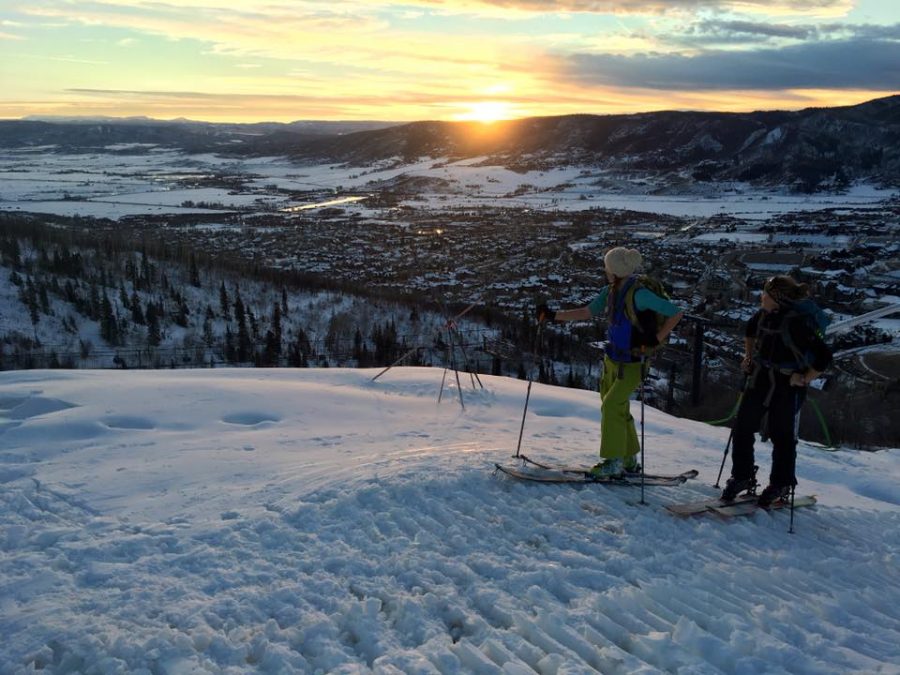Alpine Touring is Steamboat’s fastest growing winter sport.
“Hey, you’re going the wrong way!” a guy yells as he skis by, and as I’m skinning up the ski area—walking up the mountain on my Alpine Touring gear.
It seems like just as many people are walking up the mountain (or “skinning”) as skiing down it these days. Why would anyone in their right mind want to walk up the mountain when there’s a perfectly good chairlift, right? For most Steamboat locals, it boils down to one thing: exercise. It’s a great workout and changes the way you spend time on the snow. Using your own strength to go up somehow makes skiing down that much sweeter.
Maybe that’s why touring equipment is the fastest growing category in the outdoor sports market, according to Forbes. And SnowSports Industries America, the chief trade group for all “sliding sports,” called alpine/AT convertible boots “one of the hottest items” in the marketplace with a one year sales leap of 27% in 2015. While Alpine Touring equipment was originally designed for backcountry skiing, it’s becoming increasingly popular in-bounds, too, especially among Steamboat’s fitness-crazed locals.
Alpine Touring: History
Alpine Touring has a long history in Europe, where “randonee” equipment was first used. Essentially it’s a special binding that allows you to free the heel of the boot for walking with skins applied to the bottoms of skis to keep from slipping. This equipment was used “off piste” or in the backcountry where there was no chairlift access. In the United States, skiers have been using Alpine Touring equipment for backcountry skiing for years, but it has only gained popularity for use in resorts in recent years, as equipment designed specifically for fitness has become lighter and easier to use.
Earning Your Turns
The idea of walking up a mountain where there is lift access might be laughable to some, but it has gained so much popularity in recent years that it has become a sport of its own, complete with a whole slew of super lightweight, high-tech equipment. Skinning up before the lifts open has become a ritual for hardcore locals, who want to get a daybreak ski run in before work, or who reward themselves with a big breakfast at Paramount Café at the base of the ski area, after what most people would consider a monumental effort (and before most of us even wake up). More often than not, they’re also rewarded with powder turns on the way down (or at least some fresh corduroy).
Alpine Touring (AT) Equipment
What differentiates AT gear from regular alpine ski gear is the ability to walk uphill, but also to ski down the exact same way you would on regular skis, with your heel locked in. AT gear is designed to have both a “walk mode” and a “ski mode.” You will need special bindings which have a mechanism that releases the heel of the ski boot for walking uphill, and also a way to secure the heel for downhill skiing (this is where AT differs from telemark skiing, when the heel is released for both uphill and downhill mode). Alpine Touring boots are like a regular ski boot but lighter with a rubber sole and a “walk” mode for flexion going uphill. Another key piece of equipment you’ll need are skins, a tacky material adhesive that sticks to the bottom of your skis to keep you from slipping backwards when you’re climbing uphill. When you’re ready to ski down, you simply remove the skins and off you go! Finally, a backpack is essential to carry your skins on the ski down, as well as water for skinning up, and extra layers since you get hot and sweaty on the way up and warmer layers for the way down.
The best way to get started is to rent equipment and try it out. Ski Haus has a solid selection of AT equipment available for rent.
Skinning up the Steamboat Ski Area
The resort does ask that uphill skiers sign a release form and wear an arm band when they skin up the mountain. It’s important to stick to the sides of the trail to stay out of the way of downhill traffic. Obviously, a lift ticket is required if you plan to ride the lifts on the upper mountain.
Suggested Routes:
Some people like to skin from the base up to Thunderhead where they can reward themselves with a big lunch, a beer, and then a fun run down. Some people prefer to ride the gondola up to Thunderhead and then skin to Four Points Lodge or the top of Storm Peak where the trails are less crowded than on the lower mountain. A local’s favorite is to drive up Burgess Creek Road and park at the base of the Creekside Trail, which is a popular mountain bike trail in the summer and a great skin track in the winter. What’s nice about this option is that it’s in the trees, away from downhill skiers. You can skin to the base of Pony Express and then ride the lift, or continue on to Thunderhead or even beyond. Skinning is allowed on all trails, so it’s really up to you how you want to go.
No matter what, you’ll get a great workout and appreciate your time outside and on skis more than you might riding the lifts. And when at least ten people holler at you that you’re going the wrong way, just smile and wave, knowing what goes up must come down—and that’s the still the sweetest part.
*Main Photo Credit – Ben Saheb

Missy Dressen, Jacqueline Harrell and Heather Craigen enjoy an early morning hike to the Gondola, then sunny fast turns on the way down! Photo credit: Dr. Phaedra Fagley
>>>>READ NEXT STORY: The Next Big Thing is Here – Apple TV Partnership<<<<

